
Ah, travel . . . it does make one weary.
As I am typing this, I am sitting at the airport in Birmingham, Alabama (my weekday “home” for the rest of the year) waiting for my flight back to Dallas. While I love vacation, I am not a fan of travel in the least, especially when it involves five or more hours of travel on a Friday night!
But there is certainly a silver lining to every cloud. In this case, I have the rare opportunity to spend more of my weekends traveling the country (particularly the East Coast), as my employer will subsidize my weekend trips. I am already looking at the possibility of attending the $10K in New York this coming September and the $10K in Orlando in December (hopefully with several of my Florida TAWC teammates). In addition, there are several prominent Vs. System stores and players near where I am working. So, I may very well be taking a road trip to Atlanta to visit Dylan Northrup’s new shop, or even up to Florence to bother Dave Spears for a weekend.
Travel may not be any fun, but congregating with the Vs. masses is always a good time!
Paradox? Oxymoron? Paradoxymoron?
This new situation of mine is somewhat enigmatic. On one hand, I have been given a grand opportunity to visit new and different Vs. System venues across the country. While I love my home stores in Dallas and Tulsa, I really enjoy meeting and playing against Vs. System players from all over the world. However, the counterpoint to this is that my new situation doesn’t afford me the opportunity to be as involved in Vs. System as I once was. My travel arrangements provide me little to no Internet access, and I don’t really have the time to play Vs. System during the week. Where I had been playing the game three to five nights a week, I am now relegated to playing only one or two times a week. For an addict like me, that’s a pretty severe cutback.
Thinking on this caused me to pause and reflect on why I play Vs. System. Since the beginning of the game almost two-and-a-half years ago, there has been on-and-off discussion about the merits of playing professionally versus playing casually. The simple truth is that I am a very competitive person, and I want to be as good at this game as I possibly can. In fact, during my torment in audit several months back, I had seriously considered quitting my job and trying to play Vs. System at a more competitive level. I figured that if I could have the respectable amount of success that I have had with minimal competitive play and testing time, then I had the potential to do very well if I devoted myself to it.
Well, as you can tell, I did not quit my job to become a fully devoted Vs. System player. This is not because I didn’t want to play Vs. System full time; I still dream about becoming a high-caliber pro the likes of Vidi Wijaya or Michael Dalton. But I realized that the happy medium I currently enjoy suits me well. I still try to play Vs. System at a competitive level. But I also participate in more relaxed formats just to enjoy the game and all of the opportunities it presents.
Competitive success is fine, and extra money is great, but having fun with the game is what my Vs. System experience is all about!
Attack Me . . . I DARE YOU!!
You may recall from my article on Last Stand that I am a big fan of multiplayer formats. While they don’t necessarily test play skill, multiplayer formats do allow for dimensions of gameplay that aren’t normally possible in head-to-head action. More importantly, deck concepts that don’t work very well in one-on-one play can find new life in multiplayer games.
My favorite casual format is “Cutthroat” (a.k.a., “Every man for himself!”). My approach to Cutthroat is somewhat different from that of my peers, as they simply tend to play their one-on-one decks in Cutthroat games. I actually prefer to develop decks that are designed to interact with the Cutthroat environment, as they tend to find more success in the format than standard one-on-one decks do. Of course, if your deck is too effective at achieving its strategy, you may find that the other players at the table gang up on you!*
Still, impacting the table with your Cutthroat deck is far more fun than actually winning a game, because you can truly enjoy frustrating the plans and actions of your fellow players. My Cutthroat deck of choice for a good while was a modified version of the Revenge Squad / Injustice Gang deck that I featured shortly after Pro Circuit San Francisco. Lex Luthor, Nefarious Philanthropist is just plain annoying in multiplayer games. And with Fifth Dimension to keep him out of harm’s way, I made sure that Lex stayed annoying for as long as he possibly could.
However, I began to notice that a lot more than my fair share of attacks and effects started coming my way whenever I played that deck.** So, much to the relief of my fellow players, I promised to build a different Cutthroat deck to play.
I thought about my choices for a long while. While pretty much any deck is playable in Cutthroat, I prefer to play decks that have some heavily disruptive theme that tends to “mess with the game.” This got me back to thinking about one of my favorite Cutthroat cards, Anti-Life Equation. I don’t think that this card is very strong in one-on-one action, but in a Cutthroat game, it can dominate like no other. The traditional view of Vs. System holds that characters usually become stunned through combat. Thus, effects that can stun opposing characters out of combat are some of the most powerful in the game. One only needs to suffer the wrath of Roy Harper ◊ Arsenal, Sharpshooter to understand this concept.
Anti-Life Equation, then, is a veritable treasure trove of goodness if one can learn how to utilize it properly. In singles matches, this is not a simple task, as your opponent has the leverage to negotiate how much Anti-Life Equation will affect him or her. For example, if an opponent doesn’t have a stunned character, or has a character in play that he or she wouldn’t mind stunning or even can’t be stunned (think Mr. Mxyzptlk, Fifth Dimension Imp or A Child Named Valeria), then the opponent will almost always call a number that is lower than yours to gain endurance. On the other hand, if the opponent has a few particularly critical characters in play and Anti-Life Equation would cause him or her to lose one of those characters, then he or she has the flexibility to call a number higher than the one that you call. The basic premise is that, in singles play, Anti-Life Equation normally cannot create enough leverage to put your opponents in difficult positions.
This situation drastically begins to change, however, when more players enter the game. As only one player will successfully be able to avoid stunning a character, the competition gets fierce to call a number high enough. Conversely, when a board is already pretty much decimated and players simply want to try to gain as much endurance as possible, Anti-Life Equation makes it possible for you, the controller, to gain quite a bit of endurance while other players fight for the remaining numbers below yours.***
As many of you might have surmised, however, there is a small problem with this tactic. While you might stand to gain some endurance from Anti-Life Equation, you will also be forced to stun a character. For most deck strategies, even those designed for multiplayer games, this is not a prospect that holds much potential. Thus, it is important to design your deck with this situation in mind. In my early builds featuring Anti-Life Equation, I tried to feature Gole as much as possible. Gole is a rare breed of character that you actually want to see stunned. Considering that Anti-Life Equation features prominently, Gole is the perfect character to have in play when Anti-Life Equation triggers.
Gole was, for a long time, one of very few characters who actually thrived on being face down on the board. However, Infinite Crisis brought us a new mechanic that actually creates favorable conditions when your characters become stunned: vengeance! This new mechanic is one of the major themes of the Villains United team. Now we have the perfect team to join Darkseid’s Elite and the Anti-Life Equation. While our opponents are grudgingly forced to stun their prized characters, we will be flipping our guys over happily, gaining massive amounts of endurance, and triggering all kinds of ferocious effects.
It’s time to team up these DC baddies and bring a little mathematical madness to our local Cutthroat games!
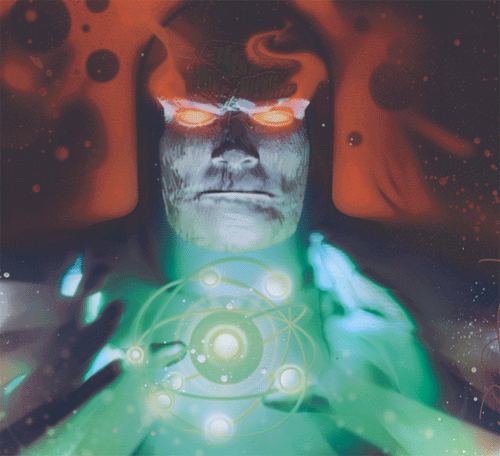
The Build
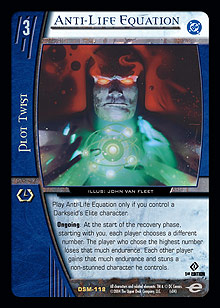 As per usual, we will be playing four copies of Anti-Life Equation. One copy is usually enough to cause our opponents fits. But getting multiple copies of Anti-Life Equation into play can create the kind of pandemonium that will make your Cutthroat games forever memorable.
As per usual, we will be playing four copies of Anti-Life Equation. One copy is usually enough to cause our opponents fits. But getting multiple copies of Anti-Life Equation into play can create the kind of pandemonium that will make your Cutthroat games forever memorable.
Our character complement is pretty straightforward. At 1, we have four copies of the aforementioned Gole (a.k.a., “The guy who had vengeance before vengeance was even cool . . . or existed, for that matter”). Also, we’re going to add some versatile search in the form of Alexander Luthor, Duplicitous Doppelganger. Despite the fact that he sits on the top of our deck and shortens our draw, Alexander Luthor is really quite good. He essentially trades the next card that we will draw for a character of our choice, provided that the character has vengeance (which pretty much all of the characters in our deck will). Finally, we’ll include four copies of The Calculator, Noah Kuttler to search out our all-important Team-Up. The Calculator won’t do much for us from a board control perspective, but he finds copies of Coercion, and he can be used to fuel return-to-hand effects like Baddest of the Bad.
Our turn 2 plays are largely optional, as we could easily play more 1-drops. However, the 2-drops can be effective for maintaining our early board, so we’ll include a few. Our first choice is two copies of Dr. Psycho, Mental Giant. In singles play, this guy is great for dealing with annoying 1-drops. In Cutthroat, however, he is an absolute pain for our opponents, as he can potentially stun any 1-drop in play. In big multiplayer games, that is usually bad news for someone at the table! Our other 2-drop is Ishmael Gregor ◊ Sabbac. Since we are playing more of a reactive deck in Cutthroat as opposed to a proactive deck, we want to play effects that deter opposing attacks. While Sabbac is a meager 2 ATK / 2 DEF, he is much like Gole in that most of our opponents will avoid attacking him out of fear of taking the subsequent endurance loss from his effect.
Our 3-drop is the most recent incarnation of the Master of Holograms, Dr. Light, Furious Flashpoint. Yes . . . Dr. Light’s stats are pitiful. But we are playing the good doctor for his effect. With a copy of Alexander Luthor in hand, Dr. Light almost single-handedly fills our curve. Just wait for the good . . . er . . . bad doctor to become stunned, play Alexander with his effect, and then activate to find any drops that you may be missing. If you pretty much already have your curve filled, then Dr. Light can be used to replay your 2-drop nuisances to great effect. While Dr. Light will probably only stay on the board for a few turns, he can have a great impact during those turns when he does see play.
Our backup 4-drop is Deathstroke the Terminator, Lethal Weapon. Much like Sabbac, Deathstroke is a defensive barrier because no one wants to attack into him and suffer the resulting endurance damage. Add in the fact that most 4-drops attacking into Deathstroke will stun back, and you have the potential to deal 8 endurance loss on any given attack. While this is not a major issue one-on-one, it can be a big deal in a multiplayer game. Speaking of multiple players, our primary drop at 4, Sinestro, Villain Reborn, is a major pain in a game with several people. Typically, players focus on attacking characters like Dr. Doom, Diabolic Genius and The Joker, Headline Stealer because they disrupt plot twist play when they’re non-stunned. Sinestro, however, has the opposite effect, shutting off all plot twists when he hits the dirt. While there may be a few brave souls willing to attack Sinestro, most players will want to keep their plot twists available.
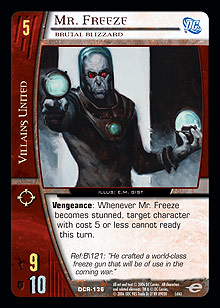 Turn 5 is all about the awesome Mr. Freeze, Brutal Blizzard. Now we are creating very difficult attacks for our opponents. Not only is Mr. Freeze tough to stun at 10 DEF, but he can also keep almost any opposing character from readying during the turn. This limitation is not quite as potent for us in multiplayer as it is in singles play. Still, it is a restriction that most opponents will not want to take on. Moreover, it can be very powerful in unison with other cards in our deck.
Turn 5 is all about the awesome Mr. Freeze, Brutal Blizzard. Now we are creating very difficult attacks for our opponents. Not only is Mr. Freeze tough to stun at 10 DEF, but he can also keep almost any opposing character from readying during the turn. This limitation is not quite as potent for us in multiplayer as it is in singles play. Still, it is a restriction that most opponents will not want to take on. Moreover, it can be very powerful in unison with other cards in our deck.
At 6, we’ll momentarily diverge from our vengeance theme to play a couple copies of Darkseid, Uxas. Since we don’t have any real strong characters with vengeance at 6, we’ll instead try out a character that has a nice synergy with Anti-Life Equation. Assuming that we get Darkseid to the recovery phase unharmed, we can use his effect to clear the board of any characters that get stunned by Anti-Life Equation. Of course, there is always the chance that Darkseid will get attacked prior to the recovery phase, in which case we’ll just have to remove his cosmic counter early. But given Darkseid’s respectable stats (particularly his 13 DEF), there’s a very good possibility that we’ll get the opportunity to unleash the Omega Effect on the board!
Turn 7 features one of Darkseid’s occasional mercenaries, Deathstroke the Terminator, Ultimate Assassin. If you thought that your opponents would be wary of attacking into the 4-drop Deathstroke, you ain’t seen nothing yet! With the potential to KO any character in play, our opponents will have to tread carefully around Mr. Wilson. Of course, if no one attacks Deathstroke, then Anti-Life Equation may just take care of the trouble of stunning him so that we can use his effect anyway!
Finally, at 8, we have a copy of The Spectre, Soulless. Thanks to his vengeance, he is searchable via Alexander Luthor. And unless things have gone horribly wrong and someone has managed to win the game via Captain Marvel, Champion of Magic, The Specter will usually mean the end of your opponents because his stunning causes the subsequent stunning of all characters in play.
Our single location choice should be a familiar one: four copies of The Science Spire.**** Since the continuous triggering of Anti-Life Equation will probably only leave us with one or two characters in play each turn, we would undoubtedly benefit from playing a card that enables us to recycle characters that would otherwise become KO’d. The Science Spire not only returns these characters to our hand, but it also allows us to cycle through our deck at a much faster pace. By seeing several extra cards every turn, we help to fill our curve and improve our chances of achieving the dream of four copies of Anti-Life Equation in play at once!
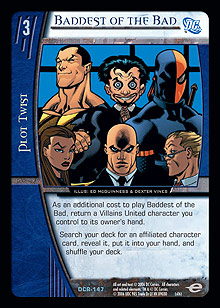 Of course, utilizing characters in play doesn’t have to be limited to activated effects of locations. That’s why we have four copies of our first plot twist, Baddest of the Bad. Where The Science Spire turns excess characters into extra deck cycling power, Baddest of the Bad turns these extra characters in play into character cards to fill our curve. The great thing about Baddest of the Bad is that it enables us to search out any affiliated character. So, if we need to get a copy of Darkseid into our hand for a later turn, then Baddest of the Bad can search him out for us as easily as it can search out a Villains United character. Versatility rules!
Of course, utilizing characters in play doesn’t have to be limited to activated effects of locations. That’s why we have four copies of our first plot twist, Baddest of the Bad. Where The Science Spire turns excess characters into extra deck cycling power, Baddest of the Bad turns these extra characters in play into character cards to fill our curve. The great thing about Baddest of the Bad is that it enables us to search out any affiliated character. So, if we need to get a copy of Darkseid into our hand for a later turn, then Baddest of the Bad can search him out for us as easily as it can search out a Villains United character. Versatility rules!
We might want to have a way to make use of all of these extra characters in our hand. That’s why we have two copies of The Exchange as a backup character search card. The Exchange is somewhat more limited than Baddest of the Bad in that it can only search out Darkseid’s Elite characters. However, it can still be handy for getting an early copy of Gole or Darkseid for us. And if we manage to get our Team-Up in play early, it will search out any of our characters (with the exception of The Spectre).
We’ve already mentioned that our Team-Up will be Coercion. This Team-Up is particularly useful in that it allows us to limit the number of Darkseid’s Elite characters (none of whom have vengeance) that we play in our deck, yet still effectively enables an early Team-Up (thanks to a preponderance of character searchers). We will only need two copies, as it is really only a catalyst to get Anti-Life Equation up and running. Even if our opponents later manage to get rid of our Team-Up, Anti-Life Equation will still be face up and in play to cause problems for our adversaries. They’d be better served by getting rid of Anti-Life Equation!
Now we come to our three “deterrent” plot twists. The first of these is Systematic Torture. In any format, KO effects are quite powerful. The Villains United team has one of the best in Systematic Torture, as it not only KO’s a character, but also tacks on a little bit of burn in the bargain.
Our next deterrent is Return Fire!. This nasty little burn card only gets better as the game progresses. By simply exhausting one of our characters, we can burn a player of our choice for endurance equal to the cost of his or her attacker. While we could be mean and do this even if we aren’t the player being attacked, Return Fire! is more effective as a punishment for aggressive opponents. Along with the other various effects in our deck, Return Fire! is yet another penalty assessed on opposing players who are brazen enough to attack us.
Finally, we come to my favorite deterrent card, Join Us or Die. This card has a wide array of uses in this deck. From a defensive standpoint, it is amazing whenever an opponent attacks Mr. Freeze, Brutal Blizzard with a 5-drop or less. Once the attack becomes legal, play Join Us or Die on Mr. Freeze, targeting the attacker with Mr. Freeze’s effect. Because Mr. Freeze became stunned during the attack, there is no longer a defender. In most cases, the attacker would ready. However, since Mr. Freeze’s effect prevents an opposing character from readying during that turn, the character that was attacking simply remains exhausted. Don’t mess with the Brutal Blizzard!
Join Us or Die also combos well with Sinestro, Villain Reborn. If you want to shut out opposing plot twists completely for a turn, use Join Us or Die on Sinestro during the draw phase. Your opponents will be forced to respond at that moment. After that, they will be unable to play plot twists for the remainder of the turn. Also, because the stun and following recovery are both part of the effect of Join Us or Die, you don’t have to worry about people responding to it with KO effects. Of course, that also assumes that the character you play Join Us or Die on is a Villains United character. In the case of The Spectre, Soulless, he would remain stunned if targeted by Join Us or Die. But it would probably still be worth it, as you could stun every character on the board by playing a single plot twist. I told you that Join Us or Die was fun!
So that does it. Let’s see if these two villainous teams produced a viable algorithm:
Mathe-madness (60 cards)
Characters (32)
4 Alexander Luthor, Duplicitous Doppelganger
4 Gole, Deep Six
4 The Calculator, Noah Kuttler
2 Dr. Psycho, Mental Giant
2 Ishmael Gregor ◊ Sabbac, Malevolent Marvel
4 Dr. Light, Furious Flashpoint
1 Deathstroke the Terminator, Lethal Weapon
4 Sinestro, Villain Reborn
3 Mr. Freeze, Brutal Blizzard
2 Darkseid, Uxas
1 Deathstroke the Terminator, Ultimate Assassin
1 The Spectre, Soulless
Plot Twists (24)
4 Anti-Life Equation
4 Baddest of the Bad
2 Coercion, Team-Up
4 Join Us or Die
4 Return Fire!
4 Systematic Torture
2 The Exchange
Locations (4)
4 The Science Spire
In a multiplayer game, initiative choice is largely a non-issue. Consequently, there really isn’t a preference, as the deck is largely reactive and defensive and does little attacking. Still, if given the choice of when you would like the initiative, turn 8 is probably your goal. That way, even if you don’t have a copy of Join Us or Die with which to stun The Spectre, you can attack with him into an opposing 8-drop to achieve the stun.
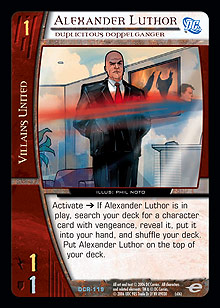 The mulligan is easy: keep any hand with Alexander Luthor, Duplicitous Doppelganger. His effect is pretty much self-perpetuating, as you can get Dr. Light, Furious Flashpoint with him and then replay Alexander Luthor with Dr. Light’s effect. This should easily allow you to hit your optimal curve for the rest of the game. Of course, there is enough search and cycling in the deck that you can easily hit your curve even without Alexander Luthor. Still, he is certainly a keeper!
The mulligan is easy: keep any hand with Alexander Luthor, Duplicitous Doppelganger. His effect is pretty much self-perpetuating, as you can get Dr. Light, Furious Flashpoint with him and then replay Alexander Luthor with Dr. Light’s effect. This should easily allow you to hit your optimal curve for the rest of the game. Of course, there is enough search and cycling in the deck that you can easily hit your curve even without Alexander Luthor. Still, he is certainly a keeper!
One word of advice. If you do play this deck or any deck featuring Anti-Life Equation in a casual multiplayer game, you might want to add the following house rule: no players may call a number larger than the greater of their total endurance, the cost of the largest character they control, or the number of people playing the game. This rule will allow for a wide variety of choices for Anti-Life Equation but prevent abuse from players about to lose the game. In one recent game, Travis McFadden (the same guy featured in last week’s column) decided to leave the game with a bang by calling one million. While I managed to talk him down to one hundred, he still significantly altered the dynamics of the game for everyone else. With over half of the players at the table at over one hundred endurance at the beginning of turn 7, everyone kind of lost interest in the game. Such is the peril of playing with the Anti-Life Equation!
And that wraps up another week of Breaking Ground. I’ll be back next week, hopefully with an interesting DC Modern deck for everyone to view. In the meantime, feel free to shoot me a message at BigSpooky1@hotmail.com.
So long, and remember: reading may be fundamental, but math is power!
* Ummm . . . not that this has ever happened to me or anything.
** Though, to be fair, I deserved every single one of them. Lex really is quite unfair in Cutthroat!
*** The simple procedure for calling endurance-optimizing numbers with Anti-Life Equation is to call n-2, where n is the number of players in a particular game. This will give you the largest possible return on the tightest distribution. For example, assume that eight players are in a game. You would call 6, as this is your endurance-optimizing amount. The remaining seven players must fight for the values 0, 1, 2, 3, 4, 5, and 7. These numbers can get larger if someone deliberately calls a high number to try to keep a character from stunning. In any case, there will always be someone who is forced to call a number higher than the one that you have called, meaning that you will always gain endurance off Anti-Life Equation (prior to stunning your character, of course).
**** “Science again! I said ‘science’ again!”